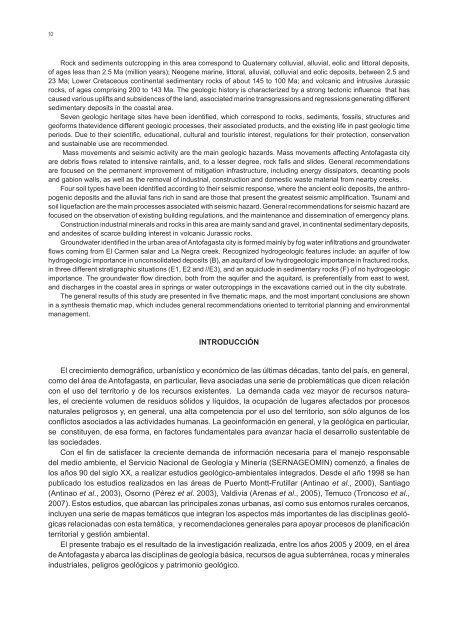GEOLOGÍA PARA EL ORDENAMIENTO TERRITORIAL ÁREA DE ANTOFAGASTA
M410_GOTAntofagasta-TX
M410_GOTAntofagasta-TX
You also want an ePaper? Increase the reach of your titles
YUMPU automatically turns print PDFs into web optimized ePapers that Google loves.
10Rock and sediments outcropping in this area correspond to Quaternary colluvial, alluvial, eolic and littoral deposits,of ages less than 2.5 Ma (million years); Neogene marine, littoral, alluvial, colluvial and eolic deposits, between 2.5 and23 Ma; Lower Cretaceous continental sedimentary rocks of about 145 to 100 Ma; and volcanic and intrusive Jurassicrocks, of ages comprising 200 to 143 Ma. The geologic history is characterized by a strong tectonic influence that hascaused various uplifts and subsidences of the land, associated marine transgressions and regressions generating differentsedimentary deposits in the coastal area.Seven geologic heritage sites have been identified, which correspond to rocks, sediments, fossils, structures andgeoforms thatevidence different geologic processes, their associated products, and the existing life in past geologic timeperiods. Due to their scientific, educational, cultural and touristic interest, regulations for their protection, conservationand sustainable use are recommended.Mass movements and seismic activity are the main geologic hazards. Mass movements affecting Antofagasta cityare debris flows related to intensive rainfalls, and, to a lesser degree, rock falls and slides. General recommendationsare focused on the permanent improvement of mitigation infrastructure, including energy dissipators, decanting poolsand gabion walls, as well as the removal of industrial, construction and domestic waste material from nearby creeks.Four soil types have been identified according to their seismic response, where the ancient eolic deposits, the anthropogenicdeposits and the alluvial fans rich in sand are those that present the greatest seismic amplification. Tsunami andsoil liquefaction are the main processes associated with seismic hazard. General recommendations for seismic hazard arefocused on the observation of existing building regulations, and the maintenance and dissemination of emergency plans.Construction industrial minerals and rocks in this area are mainly sand and gravel, in continental sedimentary deposits,and andesites of scarce building interest in volcanic Jurassic rocks.Groundwater identified in the urban area of Antofagasta city is formed mainly by fog water infiltrations and groundwaterflows coming from El Carmen salar and La Negra creek. Recognized hydrogeologic features include: an aquifer of lowhydrogeologic importance in unconsolidated deposits (B), an aquitard of low hydrogeologic importance in fractured rocks,in three different stratigraphic situations (E1, E2 and //E3), and an aquiclude in sedimentary rocks (F) of no hydrogeologicimportance. The groundwater flow direction, both from the aquifer and the aquitard, is preferentially from east to west,and discharges in the coastal area in springs or water outcroppings in the excavations carried out in the city substrate.The general results of this study are presented in five thematic maps, and the most important conclusions are shownin a synthesis thematic map, which includes general recommendations oriented to territorial planning and environmentalmanagement.INTRODUCCIÓNEl crecimiento demográfico, urbanístico y económico de las últimas décadas, tanto del país, en general,como del área de Antofagasta, en particular, lleva asociadas una serie de problemáticas que dicen relacióncon el uso del territorio y de los recursos existentes. La demanda cada vez mayor de recursos naturales,el creciente volumen de residuos sólidos y líquidos, la ocupación de lugares afectados por procesosnaturales peligrosos y, en general, una alta competencia por el uso del territorio, son sólo algunos de losconflictos asociados a las actividades humanas. La geoinformación en general, y la geológica en particular,se constituyen, de esa forma, en factores fundamentales para avanzar hacia el desarrollo sustentable delas sociedades.Con el fin de satisfacer la creciente demanda de información necesaria para el manejo responsabledel medio ambiente, el Servicio Nacional de Geología y Minería (SERNAGEOMIN) comenzó, a finales delos años 90 del siglo XX, a realizar estudios geológico-ambientales integrados. Desde el año 1998 se hanpublicado los estudios realizados en las áreas de Puerto Montt-Frutillar (Antinao et al., 2000), Santiago(Antinao et al., 2003), Osorno (Pérez et al. 2003), Valdivia (Arenas et al., 2005), Temuco (Troncoso et al.,2007). Estos estudios, que abarcan las principales zonas urbanas, así como sus entornos rurales cercanos,incluyen una serie de mapas temáticos que integran los aspectos más importantes de las disciplinas geológicasrelacionadas con esta temática, y recomendaciones generales para apoyar procesos de planificaciónterritorial y gestión ambiental.El presente trabajo es el resultado de la investigación realizada, entre los años 2005 y 2009, en el áreade Antofagasta y abarca las disciplinas de geología básica, recursos de agua subterránea, rocas y mineralesindustriales, peligros geológicos y patrimonio geológico.


